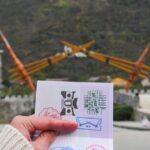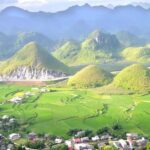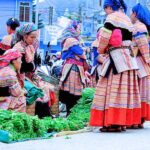Nestled at the foot of the Tay Con Linh mountain range in Vinh Quang town, the administrative center of Hoang Su Phi district, Ha Giang province, Hoang Su Phi market comes alive every Sunday morning. With a history spanning over 200 years, this market is not just a hub for trade but also a unique cultural space for ethnic minorities such as the Hmong, Dao, Tay, and Nung.
Hoang Su Phi market was established in the 19th century during the French colonial period and is one of the three largest markets in the district, along with Ban May and Nam Dich. Initially, the market served the trading needs of the Hmong, Dao, Tay, and Nung communities living in the remote mountainous region.
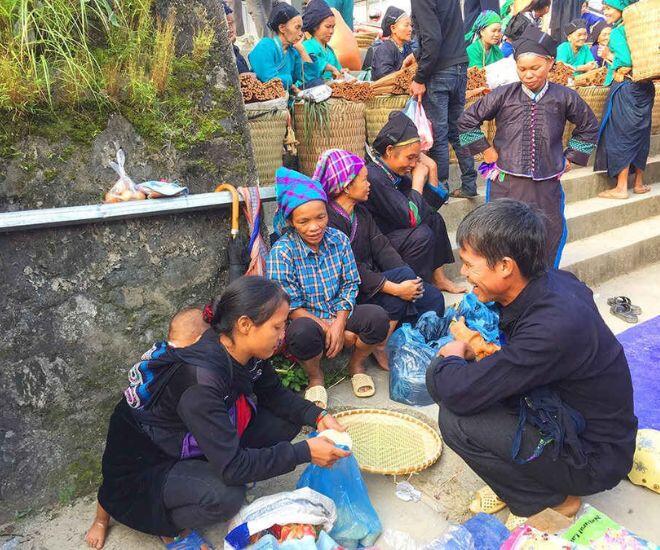
The locals often walk or use horses to transport their goods to the market, sometimes taking a few days to make the journey. The market is not just a place for trade but also an opportunity for ethnic groups to meet and engage in cultural exchanges.
The market stretches along the main street of the town, spanning a few kilometers, with the busiest area centered around Lam Dong street. This geographical location is not only convenient for trade among neighboring communes but also creates a majestic backdrop, blending the bustling market with the surrounding mountains.

In recent years, the local government has invested in infrastructure improvements and transformed the market into a cultural tourist attraction. Since 2020, the pathways and trading areas have been upgraded to be more spacious and hygienic, ensuring food safety. Despite these developments, the market has retained its traditional charm and avoided excessive commercialization.
At Hoang Su Phi market, the trading practices remain sincere and straightforward, without the hustle and bustle of aggressive bargaining. According to statistics, each market day attracts approximately 2,000–3,000 visitors, including both locals and tourists. Community-based tourism experiences often combine a visit to the market with a homestay stay, allowing visitors to gain a deeper understanding of the local culture.
A Haven for Handicrafts and Local Delicacies
Hoang Su Phi market is renowned as the “cradle of brocade” and boasts exquisite handmade textiles crafted by the Hmong and Dao people. The fabrics, adorned with geometric patterns or colorful nature-inspired motifs, have become a trademark of the region. Prices for these brocades range from 200,000 to 500,000 VND, depending on the size and complexity of the design.
In addition to textiles, the Nung ethnic group also brings intricately crafted silver jewelry to the market, including bracelets, earrings, and necklaces. Essential tools such as knives, hoes, and baskets—indispensable in daily life—are also abundantly available.
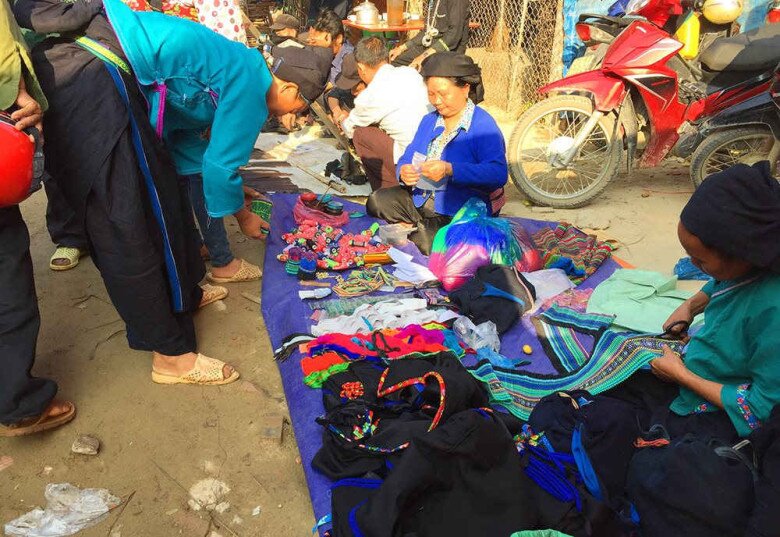
In terms of agricultural produce, the market is a melting pot of highland specialties, including Hoang Su Phi terraced rice, Shan Tuyet tea plucked from ancient trees on mountain peaks, and wild honey harvested from natural beehives. Local livestock such as black chickens, piglets carried in armlets, and mountain goats—delicacies unique to the region—are also brought to the market by the ethnic groups.
Visiting Hoang Su Phi market offers a chance to delve into the region’s distinctive cuisine. “Thang co,” a stew made from horse, beef, or pork, cooked with offal and seasoned with local spices like “mac khen” and “thao qua,” is a signature dish of the Hmong people. For just 25,000–30,000 VND, visitors can indulge in this hearty dish right at the market.
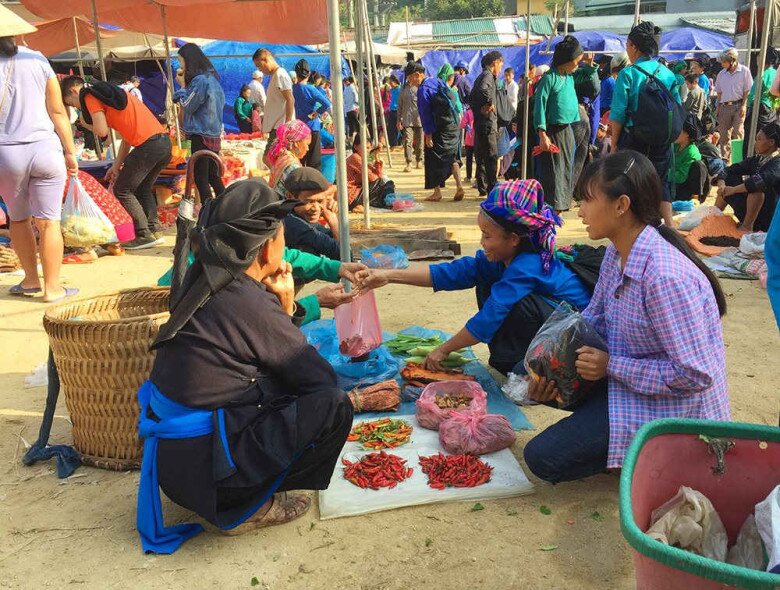
Another local favorite is “chau au tau” porridge, made from “au tau” herb roots combined with pig’s trotters, resulting in a mildly bitter and creamy dish. “Banh tam giac mach,” a triangle-shaped cake made from buckwheat flour with a subtle sweetness and distinctive aroma, makes for an ideal souvenir for visitors to take home.
Other unique delicacies like “La Chi” smoked or grilled rat meat and “ca chep ruong bac thang” (rice field carp with firm and sweet meat) showcase the ingenuity and resourcefulness of the ethnic groups in utilizing local ingredients.
Experiencing Hoang Su Phi Market
A visit to Hoang Su Phi market is a must-do on any Ha Giang exploration itinerary. Tourists have the opportunity to interact directly with ethnic groups donned in their traditional attire. Dao women, adorned with intricately embroidered clothing, and Hmong men with their distinctive headgear, create a vibrant tapestry of colors and cultures.
The market, set against the backdrop of majestic mountains, presents a photographer’s dream. Professional photographers often arrive at the crack of dawn to capture the moment when the locals descend upon the market. The morning sunlight, filtering through the thin mist, illuminates the colorful costumes, creating unique frames rarely found elsewhere.
Tips for Visiting the Market
To fully immerse yourself in the Hoang Su Phi market experience, consider the following suggestions:
The ideal time to arrive at the market is between 5 and 6 am when the atmosphere is bustling with activity. This is the perfect moment to witness the ethnic groups arriving with their highland produce.
When bargaining, remember to be gentle and friendly, especially when dealing with ethnic minority women. Aggressive haggling may dampen the cheerful atmosphere of the market.
For local specialties, consider purchasing wild honey, Shan Tuyet tea, or brocade as souvenirs. However, be sure to verify the authenticity and quality of the products.
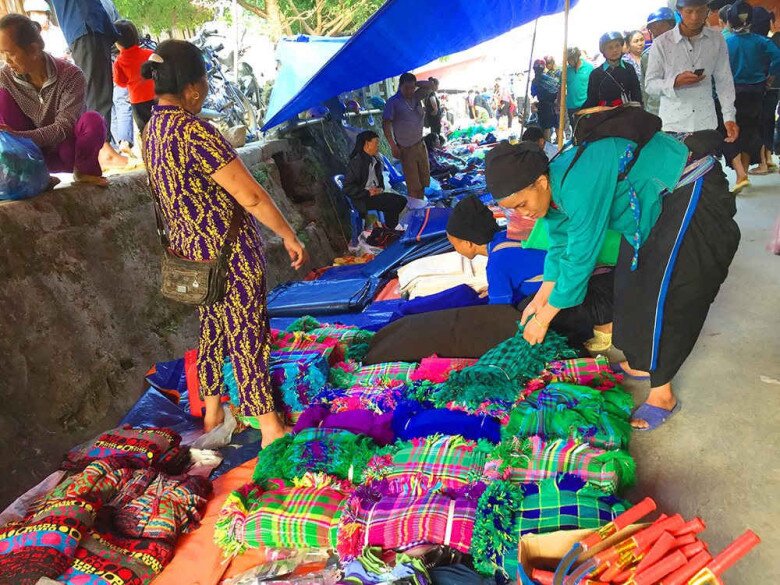
When it comes to food, opt for stalls that are popular among the locals to ensure freshness and authenticity. Always ask for permission before taking photographs of individuals or sacred objects like silver jewelry to show respect for the local culture.
In the context of thriving tourism, preserving and sustainably developing the market not only improves the livelihoods of the locals but also effectively promotes the cultural image of Ha Giang to domestic and international visitors.
A trip to Hoang Su Phi market is more than just a culinary or shopping expedition; it is an opportunity to immerse yourself in a 200-year-old cultural heritage, to slow down amidst the hustle and bustle of modern life, and to deeply appreciate the rich cultural diversity of Vietnam.
The Gen Z Trendsetters: In Pursuit of the ‘Ha Giang Passport’
The Gen Z travelers are embracing a unique and exciting trend of collecting stamps as they check off famous tourist spots in Ha Giang. This innovative way of exploring the region offers a fun and memorable experience, encouraging visitors to embark on a journey of discovery and leave with a tangible keepsake of their adventures.

























